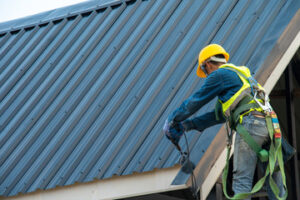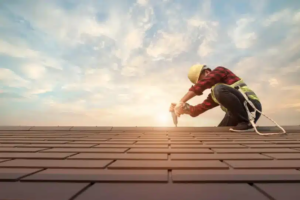Roofing Company Antioch TN plays a crucial role in maintaining, repairing, and installing roofs for residential and commercial buildings. Roofs serve as the first line of defense against the elements, providing protection from rain, wind, heat, and other environmental factors.

Ensuring that a roof is in good condition is essential for the overall structural integrity of a building, making the services of a roofing company highly valuable. Whether it is a new construction project, an urgent repair, or routine maintenance, professional roofers are skilled in handling various types of roofing systems, materials, and techniques.
One of the most critical services offered by a roofing company is installation. New construction projects require precise and careful planning to ensure that the roof is durable and long-lasting. Roofers work closely with architects, engineers, and contractors to select the appropriate materials and designs that align with the overall aesthetic and functional requirements of a building. Various roofing materials, including asphalt shingles, metal, tiles, and flat roofing systems, offer different advantages in terms of durability, energy efficiency, and cost. The choice of materials largely depends on climate conditions, budget considerations, and the desired appearance of the structure.
In addition to installation, roofing companies specialize in repairs, which are often necessary due to natural wear and tear, severe weather, or accidental damage. Roof leaks are one of the most common issues homeowners and businesses face, and timely repairs are essential to prevent further deterioration. Professional roofers conduct thorough inspections to identify the root cause of leaks, missing shingles, or weakened structures before implementing effective solutions. Addressing minor issues promptly can prevent costly replacements and extend the lifespan of a roof. Storm damage repair is another vital service provided by roofing companies, as strong winds, heavy rains, and hail can cause significant damage. Immediate action is required to prevent water infiltration, mold growth, and structural weakening.
Roof maintenance is another essential aspect of roofing services. Regular maintenance ensures that roofs remain in optimal condition, reducing the risk of unexpected repairs and extending their lifespan. A roofing company typically offers services such as cleaning gutters, removing debris, inspecting for leaks, and checking for structural damage. Preventative maintenance helps identify potential problems before they become major issues, saving property owners time and money in the long run. Seasonal maintenance is especially important in areas prone to extreme weather conditions, as roofs must be prepared to withstand heavy rainfall, snow, or high temperatures.
In addition to traditional roofing services, many roofing companies now offer energy-efficient solutions. Sustainable roofing options have gained popularity due to the growing emphasis on environmental conservation and energy savings. Cool roofs, solar panels, and green roofing systems are designed to reduce energy consumption by improving insulation and reflecting heat away from buildings. These solutions not only benefit property owners by lowering energy costs but also contribute to reducing the overall carbon footprint. Roofing companies often provide consultation services to help clients choose environmentally friendly options that align with their sustainability goals.
Professional roofing companies prioritize safety in all their operations. Roofing work involves significant risks due to heights, heavy materials, and hazardous equipment. Licensed and experienced roofers undergo training to follow strict safety protocols, ensuring that installations, repairs, and maintenance are carried out without accidents. Roofing companies invest in protective gear, scaffolding, and harnesses to protect their workers and minimize liability risks for clients. Adhering to safety standards also ensures compliance with local building codes and regulations, preventing legal issues that may arise from substandard workmanship.
Customer service is a fundamental aspect of a reputable roofing company. From initial consultations to project completion, professional roofers prioritize communication, transparency, and reliability. Clients appreciate clear estimates, detailed explanations of roofing options, and regular updates throughout the process. A roofing company that values customer satisfaction builds long-term relationships and earns a positive reputation through word-of-mouth referrals. Trustworthy contractors provide warranties on their work, giving clients peace of mind knowing that their investment is protected.
The cost of roofing services varies based on several factors, including the size of the project, the materials used, labor requirements, and the complexity of the work. While some property owners may be tempted to choose the cheapest option available, quality should always be a priority. Low-quality materials and poor workmanship can lead to frequent repairs and premature replacements, resulting in higher costs over time. A professional roofing company provides competitive pricing while ensuring high standards of quality, durability, and reliability.
Technological advancements have significantly impacted the roofing industry. Innovative tools, materials, and techniques have improved efficiency, durability, and safety. Roofing companies now use drones for inspections, allowing them to assess damage and plan repairs without the need for extensive manual labor. Advanced roofing materials with enhanced weather resistance and energy efficiency have also revolutionized the industry. Roofing companies continuously adapt to new trends and technologies to provide clients with the best possible solutions for their needs.
Finding the right roofing company requires thorough research and careful consideration. Clients should look for licensed, insured, and experienced contractors with a proven track record of delivering quality work. Reading customer reviews, checking references, and requesting detailed estimates can help in making an informed decision. A reputable roofing company is transparent about its credentials, certifications, and past projects, ensuring that clients feel confident in their choice. Clear contracts outlining the scope of work, costs, and timelines prevent misunderstandings and establish accountability on both sides.
A roofing company’s role extends beyond providing roofing services; it contributes to the overall well-being and safety of residential and commercial properties. A strong, well-maintained roof enhances property value, improves energy efficiency, and protects against environmental hazards. Whether it is a simple repair or a complete roof replacement, hiring a professional roofing company ensures that the job is done right the first time. Investing in quality roofing services is an essential step in preserving the integrity and longevity of any structure, providing comfort and security for years to come.
Beyond the fundamental services of installation, repairs, and maintenance, roofing companies are also involved in structural reinforcements. In some cases, older buildings require roof strengthening to withstand modern environmental challenges. Reinforcement techniques include additional support beams, improved insulation, and advanced waterproofing solutions. Structural improvements can significantly extend the lifespan of a roof and enhance overall safety.
Many roofing companies offer emergency services, as roofing issues can arise unexpectedly, requiring immediate attention. Severe weather conditions or unforeseen accidents can result in roof damage that poses risks to property and occupants. Emergency roofing services ensure that temporary repairs are made promptly to prevent further damage while a long-term solution is planned and executed. Roofing companies with 24/7 emergency response teams are particularly valuable in areas prone to extreme weather.
Another crucial aspect of roofing services is roof replacement. Over time, all roofs reach the end of their lifespan and must be replaced to maintain a building’s structural integrity. Roof replacement projects require careful planning, as property owners must choose materials, colors, and designs that align with their preferences and functional requirements. Professional roofing companies guide clients through the selection process, ensuring they make informed decisions that suit their budget and aesthetic preferences.
Roofing warranties provide added assurance for property owners. A reputable roofing company offers manufacturer warranties on materials and guarantees on labor, ensuring that any issues arising from defects or poor workmanship are addressed at no additional cost. Warranties vary in duration and coverage, making it essential for clients to review the terms and understand their protection. A reliable roofing company stands by its work and upholds warranty commitments to maintain customer trust.
With growing concerns about climate change and sustainability, roofing companies are increasingly incorporating environmentally friendly practices. Recycling old roofing materials, reducing waste, and using sustainable materials contribute to eco-friendly construction. Companies that prioritize green initiatives not only help the environment but also attract eco-conscious clients seeking sustainable roofing solutions.
In summary, a roofing company plays a vital role in protecting homes and businesses. Through high-quality installations, reliable repairs, and regular maintenance, professional roofers ensure that roofs remain durable and efficient. With advancements in technology, improved safety measures, and a focus on sustainability, roofing companies continue to evolve to meet modern demands. Choosing a reputable and experienced roofing company ensures long-term benefits, providing security, value, and peace of mind for property owners.
